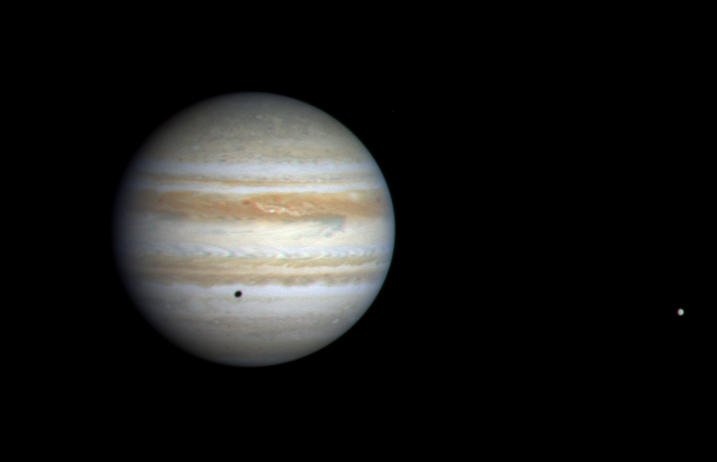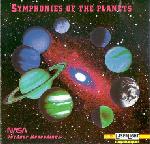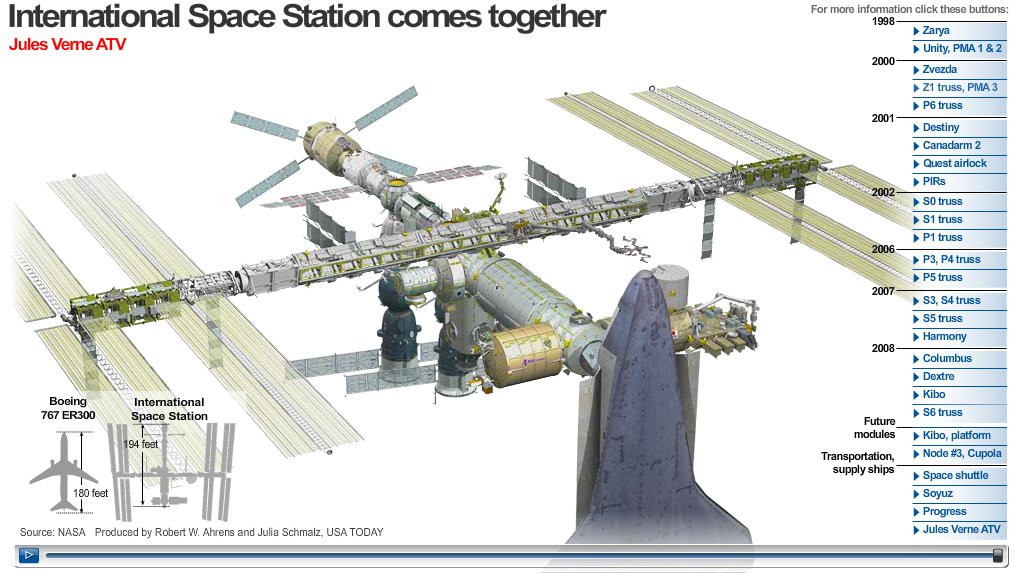It’s not that I’m so smart; it’s that I stay with the problem longer.
[Albert Einstein]
Category Archives: Science
Hubble look at Pluto
 Since its discovery in 1930, Pluto has been a speck of light in the largest ground-based telescopes. But NASA’s Hubble Space Telescope has now mapped the dwarf planet in never-before-seen detail. The new map is so good, astronomers have even been able to detect changes on the dwarf planet’s surface by comparing Hubble images taken in 1994 with the newer images taken in 2002-2003. The task is as challenging as trying to see the markings on a soccer ball 40 miles away.
Since its discovery in 1930, Pluto has been a speck of light in the largest ground-based telescopes. But NASA’s Hubble Space Telescope has now mapped the dwarf planet in never-before-seen detail. The new map is so good, astronomers have even been able to detect changes on the dwarf planet’s surface by comparing Hubble images taken in 1994 with the newer images taken in 2002-2003. The task is as challenging as trying to see the markings on a soccer ball 40 miles away.
Hubble’s view isn’t sharp enough to see craters or mountains, if they exist on the surface, but Hubble reveals a complex-looking and variegated world with white, dark-orange, and charcoal-black terrain. The overall color is believed to be a result of ultraviolet radiation from the distant Sun breaking up methane that is present on Pluto’s surface, leaving behind a dark, molasses-colored, carbon-rich residue. Astronomers were very surprised to see that Pluto’s brightness has changed — the northern pole is brighter and the southern hemisphere is darker and redder. Summer is approaching Pluto’s north pole, and this may cause surface ices to melt and refreeze in the colder shadowed portion of the planet. The Hubble pictures underscore that Pluto is not simply a ball of ice and rock but a dynamic world that undergoes dramatic atmospheric changes.
Click the image to enlarge. Original site is here.
Earthrise
Some years ago, the japanese Kaguya spacecraft orbited the moon with a HD camera onboard and take this movie.
The colors of the Earth rising above the horizon suggest our planet is a beautiful place to see from far away.
Sorry for the music and the comments.
from: Open Culture
The Known Universe in Six Minutes
The Known Universe takes viewers from the Himalayas through our atmosphere and the inky black of space to the afterglow of the Big Bang. Every star, planet, and quasar seen in the film is possible because of the world’s most complete four-dimensional map of the universe, the Digital Universe Atlas that is maintained and updated by astrophysicists at the American Museum of Natural History. The new film, created by the Museum, is part of an exhibition, Visions of the Cosmos: From the Milky Ocean to an Evolving Universe, at the Rubin Museum of Art in Manhattan through May 2010.
Little Snowman
For most children the challenge is trying to build the biggest snowman.
Scientists, however, enjoy taking on altogether trickier tasks.
They have built the world’s smallest snowman, measuring just 0.01mm across – one fifth of the width of the average human hair.
Made of two tiny tin beads usually used to calibrate electron microscope lenses, the snowman was built by the National Physical Laboratory.
It was assembled using tools designed to manipulate nano-particles, and welded together with tiny deposits of platinum.
A focused ion beam was used to carve the eyes and smile, and to place the platinum nose.
The snowman was created by Dr David Cox, a member of the Quantum Detection group at the laboratory.
The National Physical Laboratory is one of the UK’s leading science facilities and research centres. It is a world-leading centre of excellence in developing and applying the most accurate measurement standards.
From Dailymail online
NASA Image Archive
The huge NASA Image Archive is now online thanks to the Internet Archive.
The site nasaimages.org is divided into five sections: Universe, Solar System, Earth, Aeronautics, and Astronauts, but the content is also indexed by a nice timeline.

Aurora from Saturn
 From the NASA site, last news about the Cassini mission.
From the NASA site, last news about the Cassini mission.
An aurora, shining high above the northern part of Saturn, moves from the night side to the day side of the planet in this movie (QuickTime, no audio, 9 MB) recorded by Cassini.
These observations, taken over four days, represent the first visible-light video of Saturn’s auroras. They show tall auroral curtains, rapidly changing over time when viewed at the limb, or edge, of the planet’s northern hemisphere. The sequence of images also reveals that Saturn’s auroral curtains, the sheet-like formations of light-emitting atmospheric molecules, stretch up along Saturn’s magnetic field and reach heights of more than 1,200 kilometers (746 miles) above the planet’s limb. These are the tallest known “northern lights” in the solar system.
These auroral displays are created by charged particles from the magnetosphere that plunge into the planet’s upper atmosphere and cause it to glow. The magnetosphere is the region of electrically charged particles that are trapped in the magnetic field of the planet. The auroral curtains shown in the movie reveal the paths that these charged particles take as they flow along lines of the magnetic field between the planet’s magnetosphere and ionosphere.
The day side of Saturn scatters light toward Cassini, creating the overexposed triangle at the center of the left of the frame. Stars can be seen above the limb of the planet, trailing across the field of view.
Symphonies of the Planets 1
 In the August and September 1977, two Voyager spacecraft were launched to fly by and explore the great gaseous planets of Jupiter and Saturn.
In the August and September 1977, two Voyager spacecraft were launched to fly by and explore the great gaseous planets of Jupiter and Saturn.
Voyager I, after successful encounters with the two, was sent out of the plane of the ecliptic to investigate interstellar space.
Voyager II’s charter later came to include not only encounters with Jupiter (1979) and Saturn (1981), but also appointments with Uranus (1986) and Neptune (1989).
The Voyagers are controlled and their data returned through the Deep Space Network, a global spacecraft tracking and communications system operated by the JPL for NASA.
Although space is a virtual vacuum, this does not mean there is no sound in space. Sound does exist as electronic vibrations. The especially designed instruments on board of the Voyagers performed special experiments to pick up and record these vibrations, all within the range of human hearing.
These recordings come from a variety of different sound environments, e.g. the interaction of the solar wind with the planet’s magnetosphere; electromagnetic field noise; radio waves bouncing between the planet and the inner surface of the atmosphere, etc.
In 1993 NASA published excerpts from these recordings in a set of 5 CD (30 minutes each) called Symphonies of the Planets (now out of print).
This is the CD 1.
- Voyager recordings – Symphonies of the Planets 1
ISS cresce
Molto bella questa animazione di USAToday che mostra la crescita della Stazione Spaziale Internazionale (ISS), con spiegazioni particolareggiate sui vari moduli che la compongono.
La ISS ormai è ben più grande di un Boeing 767 e comincia ad assomigliare a una stazione spaziale come le immaginavo da piccolo.
Il canto degli antenati
 Qualche report sui libri letti durante l’estate. Inizio con il bellissimo “Il canto degli antenati” di Steven Mithen (Tit. orig. The singing neanderthal, 2005). Sottotitolo: Le origini della musica, del linguaggio, della mente e del corpo.
Qualche report sui libri letti durante l’estate. Inizio con il bellissimo “Il canto degli antenati” di Steven Mithen (Tit. orig. The singing neanderthal, 2005). Sottotitolo: Le origini della musica, del linguaggio, della mente e del corpo.
Mithen, archeologo britannico, parte da un assunto: la propensione a fare musica è uno dei più misteriosi, affascinanti e allo stesso tempo trascurati tratti distintivi del genere umano. La letteratura scientifica ha sottovalutato questo campo di studio, definendo la musica come una tecnologia, un prodotto, creato unicamente a scopo ludico e ricreativo, e non come un adattamento selettivo. Diversamente, Mithen sostiene che lo studio dell’origine del linguaggio, e più in generale dell’abilità comunicativa dei nostri antenati, dovrebbe essere rivalutato alla luce dell’aspetto musicale, che a sua volta non può prescindere dall’evoluzione del corpo e della mente.
Si tratta di un’idea che per molti musicisti è intuitivamente vera, ma che finora non era stata sostenuta dalla letteratura scientifica e dalla ricerca. Ma l’ipotesi di Mithen va più in là. Citando la recensione di Giuseppe Mirabella su Le Scienze (Apr. 2007):
La musica è un elemento proprio di tutte le culture umane. Strumenti musicali, canti e danze rituali fanno parte di tutte le società, da quelle moderne alle più primitive. E l’enorme diffusione delle abilità musicali ha fatto ipotizzare che questa capacità avesse un ruolo evolutivo. Ma quale può essere stato il vantaggio selettivo offerto dalla musica ai nostri antenati? Steven Mithen, archeologo cognitivo dell’Università di Reading, prova a formulare una teoria molto accattivante, secondo la quale i primi ominidi comunicavano attraverso un linguaggio musicale, un miscuglio tra il linguaggio e la musica come li intendiamo noi oggi. Secondo Mithen, questa forma di comunicazione avrebbe toccato l’apice nei neandertaliani. Che avevano una configurazione delle alte vie respiratorie che avrebbe consentito loro di parlare, ma non disponevano dei circuiti nervosi deputati al controllo del linguaggio. Le difficili condizioni ambientali in cui vivevano e la crescente complessità dei loro gruppi sociali richiedevano uno scambio continuo di informazioni, e quindi si sviluppò un sistema di comunicazione articolato che includeva sia suoni sia gesti del corpo.
Per definire il sistema di comunicazione dell’uomo di Neanderthal, Mithen ha coniato l’acronimo “Hmmmm”, per olistico (holistic), multi-modale, manipolativo and musicale (invidio molto la facilità dell’inglese nella creazione di acronimi):
“Its essence would have been a large number of holistic utterances, each functioning as a complete message in itself rather than as words that could be combined to generate new meanings.”
Probabilmente anche i primissimi Homo sapiens comunicavano in questo modo, ma lo sviluppo del cervello consentì loro di evolvere un vero e proprio linguaggio dotato di una grammatica, cioè di un sistema per combinare i simboli base a formare nuovi significati. L’ipotesi di Mithen è necessariamente di natura speculativa, ma le prove indirette che porta a suo sostegno sono numerose e convincenti.
NB: il libro è effettivamente affascinante, ma non facilissimo. È un trattato scientifico che deve prendere in considerazione, riferire e valutare le ricerche e gli esperimenti condotti finora. Di conseguenza, a tratto, non è discorsivo e scorrevole. Vivamente consigliato a coloro che nutrono un interesse particolare per questo argomento.


